Sea World San Diego (Part I)

This is the first part (of three) of photos from my recent trip to Sea World San Diego. I took over 300 digital photos and two rolls of film, so I have a lot to go on here.
One thing that's important to know before coming here though is that you might spend at least $100 before you see one animal. Between the entrance fee $50.95 (although there is a AAA discount), a tour fee, and a "Dining With Shamu" fee, I dropped a lot more money that I thought I was going to.
That's because I was thinking "zoo" instead of "Disney". If you remember that it's a theme park, you'll bring your credit card.
 Sea World, first and foremost, is a theme park. It's about fun, interaction, and beer. Some of these factors come into play later (espescially part three) and have some unfortunate consequences, but overall this place is about having a good time and is well worth the money.
Sea World, first and foremost, is a theme park. It's about fun, interaction, and beer. Some of these factors come into play later (espescially part three) and have some unfortunate consequences, but overall this place is about having a good time and is well worth the money.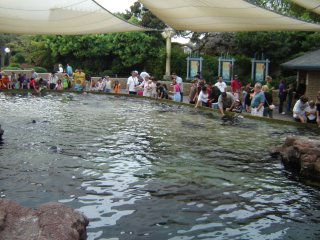 One good example of the theme park feel is the California Tide Pool, where you can stick your hands in the water and touch things like Bat Rays and Stingrays. These fish have a coat of mucus on their skin that's pretty nasty to touch.
One good example of the theme park feel is the California Tide Pool, where you can stick your hands in the water and touch things like Bat Rays and Stingrays. These fish have a coat of mucus on their skin that's pretty nasty to touch. You can get right up to them, examine them, etc. You can do everything but cook them. They're not too keen on that here.
You can get right up to them, examine them, etc. You can do everything but cook them. They're not too keen on that here. Guided tours are offered at an extra fee (and not a nominal one). I took the "Saving a Species" tour, which allows you to feed endangered sea turtles, touch sharks, and learn about the manatee, an animal I had never heard of. You also get to learn a little bit about Sea World's activities in preserving and protecting these animals.
Guided tours are offered at an extra fee (and not a nominal one). I took the "Saving a Species" tour, which allows you to feed endangered sea turtles, touch sharks, and learn about the manatee, an animal I had never heard of. You also get to learn a little bit about Sea World's activities in preserving and protecting these animals.The Avian Propagation Center, which is an incubator and a research facility of rare birds is above. It is one of the key "behind the scenes" activites of the center. They call it a "managed breeding" center. Oh my.
Nearby, we went to a similar facility dedicated to sharks, where we were allowed to pet baby sharks of all kinds. Their scales are smooth from head to tail, and rough from tail to head. This undoubably is a process of natural selection that gives the sharks an edge when swimming.
With the tour came the obligitory "sharks don't hurt people" speech, which I've heard a million times now. Just once, I'd like to hear someone say "don't f*ck with sharks, they can smell one drop of blood in a million drops of water and come and get you".
 They do have a sensitive sense of smell, and can also read electrical patterns and vibrations in the water. Sharks may be more sensitive to electricity than any other animal, and every living animal (that we know of) emits some form of it. Sharks have no known predator, except Hollywood motion pictures.
They do have a sensitive sense of smell, and can also read electrical patterns and vibrations in the water. Sharks may be more sensitive to electricity than any other animal, and every living animal (that we know of) emits some form of it. Sharks have no known predator, except Hollywood motion pictures.Smell is extremely important to the shark, and 2/3rd of its brain is dedicated to it. Sight on the other hand, is less important. Sharks go blind when they are on the attack.
In reality, less than 100 people per year are killed by shark attacks. 30 to 100 million sharks are killed by humans, according to this Website. This fear the sharks thing just comes from the evil liberal media.
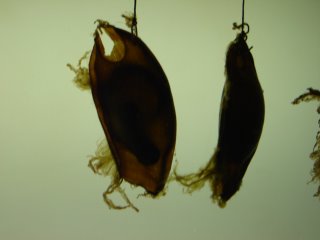 Here's what a shark looks like prebirth. Sea World incubates them.
Here's what a shark looks like prebirth. Sea World incubates them. The largest part of the "endangered" part of the theme park is the exhibit on the manatee. In fact, it's the only place in the complex where they even touch upon the fact that many of Earth's animals are in danger. Because Sea World is a for-profit venture owned by a larger conglomerate, they don't seem to want people to feel bad and stop consuming.
The largest part of the "endangered" part of the theme park is the exhibit on the manatee. In fact, it's the only place in the complex where they even touch upon the fact that many of Earth's animals are in danger. Because Sea World is a for-profit venture owned by a larger conglomerate, they don't seem to want people to feel bad and stop consuming.Nevertheless, the Mantee exhibit is a good one. It explains that the animal is in danger both for environmental reasons (it is very sensitive to changes in water temperature -- especially as it gets cold) and human reasons, with many of these animals being hit by boats sailing near the coastline.
It's a pretty stupid animal. It has no memory and therefore dos not remember its enemies or dangers. It does not sleep either; it uses one half of its brain at a time (while the other one is at rest). This is a matter of dispute online, but I'm going to go with what my guide told me.
Best of all, it needs to remind itself to breathe. As dumb as I am, I can remember to do that.
 Sea World takes care of a number of turtles, which are also endangered due to their low successful reproductive rate and habitat damage.
Sea World takes care of a number of turtles, which are also endangered due to their low successful reproductive rate and habitat damage.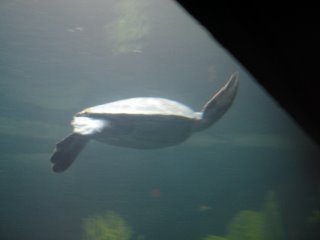 90% of the offspring of turtles, which are buried in the ground before their eggs hatch, do not make it back into the ocean.
90% of the offspring of turtles, which are buried in the ground before their eggs hatch, do not make it back into the ocean. Turtles do not like to be touched. The best we can do to feed them is throw lettuce at them. That's fun, but they gotta show us a little bit more love for me to care about them.
Turtles do not like to be touched. The best we can do to feed them is throw lettuce at them. That's fun, but they gotta show us a little bit more love for me to care about them.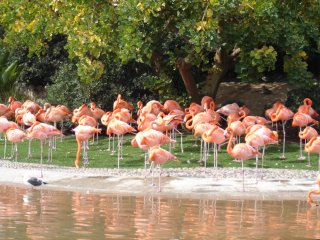 Sea World has a nice collection of flamingos, which are pink because they eat a lot of shrimp. Really. Well, sometimes.
Sea World has a nice collection of flamingos, which are pink because they eat a lot of shrimp. Really. Well, sometimes. My favorite new animal of the day is the mudskipper. They spend most of their time ashore, using up water stored during periodic exits from the land. I think I had a staring match with this guy for 15 minutes.
My favorite new animal of the day is the mudskipper. They spend most of their time ashore, using up water stored during periodic exits from the land. I think I had a staring match with this guy for 15 minutes.He won.
 He's not going to be like the other fish and limit himself to just land or just water. Not this dude. He likes...mud. They eat insects, making them useful pets (if you don't mind having mud in your place). What a great animal.
He's not going to be like the other fish and limit himself to just land or just water. Not this dude. He likes...mud. They eat insects, making them useful pets (if you don't mind having mud in your place). What a great animal. Sea World has a number of aquariums that are the home to various exotic and exciting species. The one above, the lionfish, is venomous! Don't mess with the lionfish!
Sea World has a number of aquariums that are the home to various exotic and exciting species. The one above, the lionfish, is venomous! Don't mess with the lionfish!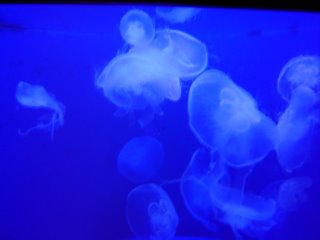 Also on display is the moon jellyfish. The circles you see within the bodies are their reproductive organs.
Also on display is the moon jellyfish. The circles you see within the bodies are their reproductive organs.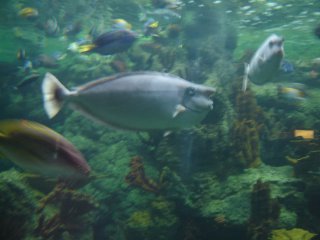 Here is a short-nosed unicorn fish, which seems to be pretty rare. I had a hard time finding out information about it, other than the fact that few people can figure out what the various unicorn fish do with their protruding nose.
Here is a short-nosed unicorn fish, which seems to be pretty rare. I had a hard time finding out information about it, other than the fact that few people can figure out what the various unicorn fish do with their protruding nose. Here are some freshwater turtles, which are endangered. In case you're wondering, all eight kinds of turtles are.
Here are some freshwater turtles, which are endangered. In case you're wondering, all eight kinds of turtles are.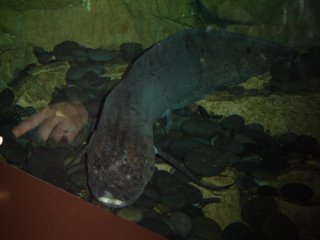 The African Lungfish lives in mostly shallow water and survives seasonal dryness by hybernating. They can survive out of water for years by creating a slime-covered cocoon. When seasonal rains return, the lungfish comes back out. Fascinating.
The African Lungfish lives in mostly shallow water and survives seasonal dryness by hybernating. They can survive out of water for years by creating a slime-covered cocoon. When seasonal rains return, the lungfish comes back out. Fascinating. This is all fun, I know. But Sea World has a hidden main event (aside from Shamu, which I'll get to in my next post): they have penguins.
This is all fun, I know. But Sea World has a hidden main event (aside from Shamu, which I'll get to in my next post): they have penguins.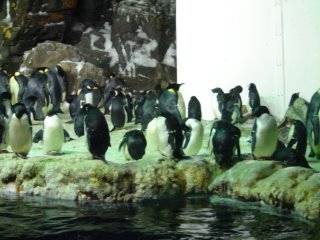 They have a lot of penguins. At least a couple of hundred on display.
They have a lot of penguins. At least a couple of hundred on display. Penguins feature waterproof feathers -- up to 70 per square inch -- which keep them warm. This guy likes to show off his stuff. After watching the penguins for a while, I got the impression that they like to stand around and do nothing a lot. I guess there's really not much to do in the winter.
Penguins feature waterproof feathers -- up to 70 per square inch -- which keep them warm. This guy likes to show off his stuff. After watching the penguins for a while, I got the impression that they like to stand around and do nothing a lot. I guess there's really not much to do in the winter.In this post, I focused mostly on the animals, which oddly enough is not the main feature of the park. There is a lot more to cover, which I will get to in the next two posts.
Stay tuned!
RELATED LINKS:
America's Treasures
Archive of Religion, Science and Philosophy



4 Comments:
I would imagine that it's generally a good policy to avoid things that can kill you...even if they are unlikely to do so. Sharks would be a good example of that.
Roseate spoonbills also supposedly get their pink color from eating shrimp. Not 100% sure if I believe it, but it is on the signs at a federal wildlife refuge, so it MUST be true, right?
Can't wait to hear what trouble you got into by mixing "fun, interaction and beer" ... sounds almost like a date, doesn't it? Or else an unexpected stumble into the shark tank? With 300 pictures on your camera, we can only hope that the eagerly anticipated Part 3 will at least be well-documented.
Anonymous, I kind of wish I didn't promote part III so much, as there is no way it can live up to expectations. I'm sure it will be a memorable report, but probably not for the reasons why you're thinking.
If anything, it will probably offend someone.
DDD, I'm very single too. Although that may be other womens' ways of avoiding things that can kill them.
Post a Comment
|<< Home